m (necessary for Special:UnusedVideos to work) |
|||
| (One intermediate revision by one other user not shown) | |||
| Line 1: | Line 1: | ||
[[File:SesamstraatLogo.jpg|300px|right]] |
[[File:SesamstraatLogo.jpg|300px|right]] |
||
| − | [[ |
+ | [[File:Sesamstraat Show Open|thumb|right|300px|The show's opening from seasons 28-30.]] |
[[Image:sesamstraat1.jpg|frame|Pino, Tommie, Purk and Ieniemienie]] |
[[Image:sesamstraat1.jpg|frame|Pino, Tommie, Purk and Ieniemienie]] |
||
[[File:Groeppoppen.jpg|thumb|300px]] |
[[File:Groeppoppen.jpg|thumb|300px]] |
||
Revision as of 23:26, 19 June 2014

Sesamstraat Show Open
The show's opening from seasons 28-30.
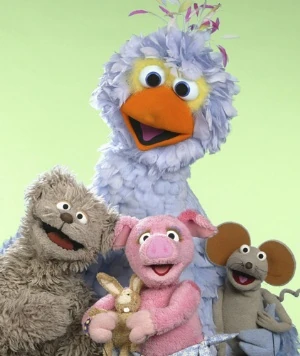
Pino, Tommie, Purk and Ieniemienie
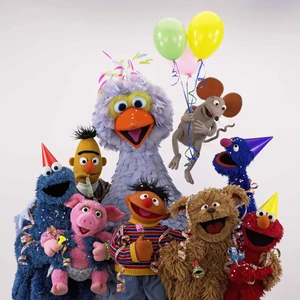
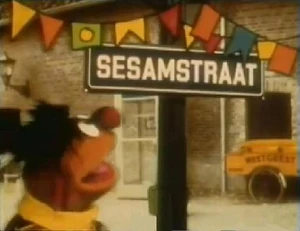
Title card in 1976
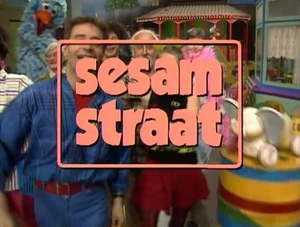
Title card in the 80s
Sesamstraat is the Sesame Street co-production that airs in the Netherlands. It is produced by NTR.
The Dutch Muppet characters are Pino (the Dutch Big Bird), Tommie, Ieniemienie, Purk, Angsthaas and Stuntkip.
Troel, a white female puppet with similar looks as Tommie, was featured during the second season. The actors portray abstracted roles of typical caretakers, such as a working mother, modern father, grandmother, grandfather, big sister, et cetera.
Like most of the American Sesame Street characters, Pino and Tommie went through major changes through the years. The first Pino started out as a plump, messy-looking bird with smaller eyes. Over the years, he lost a little weight, his white tummy became blue like the rest of his body, his legs grew, and his eyes switched from realistic to cartoonlike, and from blue to black. In 1999, in order to make him look younger, his beak was shortened, he got yellow feathers around his eyes and he got colorful feathers on his head For Tommie, he evolved from a 'teddy bear' kind of creature to a more doglike animal, and is occasionally referred to as a dog.
Each episode is centered around a certain theme, like "Animals", "Fear", "Traffic", "Death/Sad", etc. There is also a bit more freedom about subjects like 'going to the bathroom' or 'saying dirty words'. Sesamstraat doesn't focus primarily around letters and numbers, like the American Sesame Street does, but rather around social values. Unlike the original target group in America, all the children in the Netherlands get to learn letters and numbers in school. Some of the cognitive items are adjusted to fit in the Dutch education; letters of the alphabet, for instance, are pronounced phonetically (the letter M is pronounced "m" instead of "em") so that children know how to use them when learning how to read.
A regular Sesamstraat episode starts with a street sequence, and usually ends with one of the actors reading a story to the Muppets or children visiting the set. Fifty percent of the show consists of dubbed American inserts, the other 50 percent is original Dutch material. The Dutch material consists of street scenes (including recurring scenes), "music videos" (both live action and cartoons), performances by mime artists, clowns and puppeteers (like Hakim and Lejo) and live action scenes on location with kids.
A new quantity of American clips is dubbed for each season, whereas clips from earlier seasons still remain a big part of the series as well. Edited episodes of Elmo's World have been featured since the new 25 minute format change, as well as Global Grover. Two of the most popular American characters are Bert and Ernie, thanks to their voice artists who are allowed to write their own material for audio recordings. Big Bird and the American human cast don't appear on Sesamstraat (aside from imported American videos dubbed into Dutch).
History
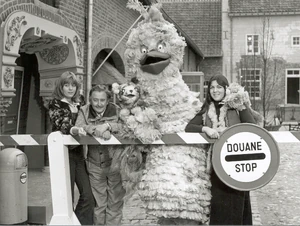
The Sesamstraat cast of 1976
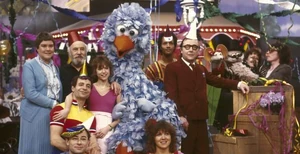
The Sesamstraat cast (1980s)
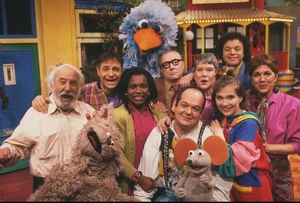
The Sesamstraat cast (1990s)
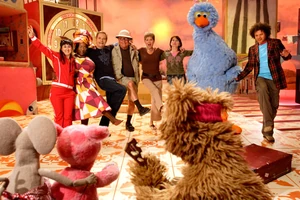
Group dancing (2000s)
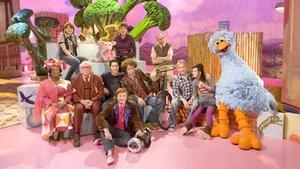
The Sesamstraat cast (2010s)
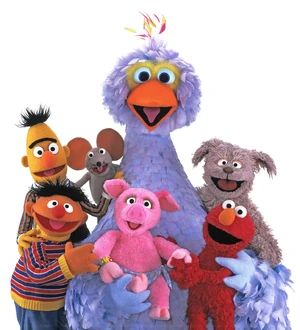
Ernie, Bert and Elmo with Pino, Tommie, Ieniemenie and Purk.
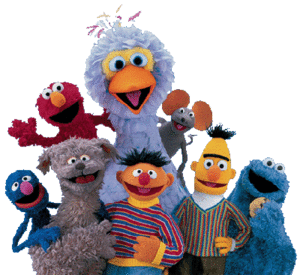
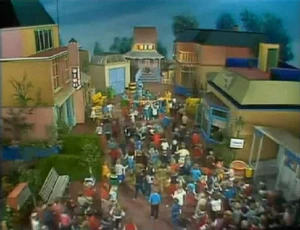
A shot from the show's sixth season opening sequence in 1982.
After a pilot episode entitled Sesamplein (Sesame Square), Sesamstraat began broadcasting in 1976. It started as a Dutch/Belgian coproduction, with only one thirty-minute episode a week. These episodes had only 12 minutes allotted for the Dutch cast. At this time there were only two Muppets and three live actors, Piet Hendriks, Sien Diels, and Annet van Heusden. Piet, who owned a hobby and crafts workshop and a camper which he would drive around The Netherlands and Belgium for live trips. Sien, who owned a grocery store, where the exchange of knowledge and happenings were as important as the selling of products. And Annet, who played a kindergarten teacher. In 1978, Sesamstraat's format changed to a daily 15 minute show that aired in the evening, around dinnertime. Starting in September 2006, Sesamstraat expanded to 30 minutes and airs three times a day.
The first season was shot on location in a half Dutch, half Belgian town. It was broadcast every Sunday for a half-hour in the afternoon. For the second season, a realistic town square was built inside the studio, which slowly evolved into a more abstract, colorful town, featuring Pino's nest, Sien's store, a workshop, two houses, an apartment building, a trailer and a treehouse. The insides of the house sets could be decorated in different ways, so that the viewers would never be certain about who lived where.
For the 2005/2006 season, Sesamstraat moved into new scenery. The set became completely abstract, with toy block-like buildings, broccoli for trees, and a tower with a giant light-up clock. The scenery was introduced with a TV special. Bert, Ernie, Cookie Monster, and Elmo flew over to Holland for this special occasion. It was the first time the American characters visited the Dutch street.
Other special Sesamstraat episodes include the 2500th episode, and a yearly special episode focused on Sinterklaas. The 25th Anniversary series in which Dutch celebrities made guest appearances on the street. On January 7th, 2000, Prime Minister Wim Kok read the daily story "Er staat een olifantje in het gras..." (There is a little elephant standing in the grass) for the Muppet residence before they went to sleep. Wim Kok is one of the many prominent guests who read a story to them. (Normally this was done by Frank, Gerda or Paula). Other celebrities that have made guest appearances are: Freek de Jonge (Comedian), Ruud Gullit (Professional soccer player), André van Duin (Comedian), Mary Dresselhuys (Actress), Hans Dagelet (Actor), Kees van Kooten (Writer), Brigitte Kaandorp (Comedian), Sonja Barend (Show host) and Janine Kastelijn (Youth Winner for Reading in 2000) and Wim T. Schippers (dutch voice actor for Ernie & Kermit).
In 1992, a 30 minute film, Sesamstraat en Melkweg, was produced for the Artis Zoo Planetarium in Amsterdam.
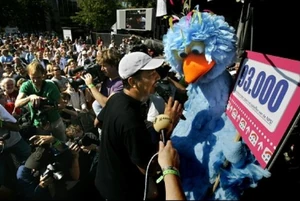
Pino protests for the preservation of NPS
In 2005 the show saw some schedule trouble. The government decided to halt the funding and broadcasts of NPS. After this news, a large protest from all of the programs and actors was held on September 5, 2005 in Den Haag (The Hague), including characters from Sesamstraat. Since the show had just moved into the new set, Pino loudly expressed himself by saying, "NPS must stay! We just moved and I don't feel like packing my toy pets again". With these words, the big Sesamstraat-bird showed what he thought about the government and the public network's plans.
At "het Plein" in Den Haag, Pino and comedian/TV host Jörgen Raymann presented 93,000 signatures supporting NPS to the cabinet representatives. During the day, several NPS artists protested on two stages. Among them were Wieteke van Dort (Klokhuis), the band Relax and from Metropole Orkest's "The Bigband". This protest was also featured on television with an interview done by Aart Staartjes, with Bert and Ernie.
The final debate took place on September 12th, 2005 in the Tweede Kamer. It was decided that NPS could continue making programs, but it had to make a several changes to fit into modern television. A new broadcast schedule was put in place, which meant that Tommie, Pino, Ieniemienie and all the other characters on Sesamstraat had to move to a new time… again! This was the fourth time that the broadcast time for the NPS children’s program had changed in the previous five years.
Not only did Sesamstraat move broadcast times, but channels as well. It moved from Nederland 3 to Nederland 1. A spokesman said they weren’t happy about the change. "It's positive for Sesamstraat to move to Nederland 1 (the expanded family network). But we can't deny the problems all this shifting causes. With every shift we're loosing viewers."
In 2008, the show got 15 minutes of extra broadcast time a day. This meant there was room for two more Muppets. Angsthaas and Stuntkip were introduced.
In 2009, the show saw more schedule trouble. Because NPS wanted to make some trail shows regarding a multi-cultural show, it was decided to move Sesamstraat from 17:30h to 17:00h. The program makers and many fans protested against the time change. It was even brought before parliament, but was thrown out because the government may not get involved in decisions of the NPS Board of Directors. This was the fifth time in just a few years that the show had moved times. This was a controversial change, opponents argued that many children in the Netherlands have two working parents, and that they wouldn't at home at this time of day to watch the show.
October 2009 brought a new segment for the show. Several famous Dutch singers perform duets with the Sesamstraat characters Pino, Tommie, Ieniemienie and Purk. All songs were written by Henny Vrienten. The segments air every Friday starting October 30, 2009. Among the artists are Trijntje Oosterhuis, André van Duin, Edsilia Rombley, Ernst Daniël Smid, Hind, Guus Meeuwis, Huub van der Lubbe and Willeke Alberti.
All the duets were broadcast again in a special on December 25 and 28.
In January 2014, the show underwent a format change. Episodes were now 15 minutes instead of 25, now featuring a recurring plot throughout the show. The time was filled with a new mini-series, 10 voor, featuring inserts starring various Sesame Street characters. The reasoning behind the change was due to budget cuts, as well as studies showing kids would pay better attention in a shorter, more focused format.[1]
Exhibits
Several exhibits were shown in the Netherlands regarding the show. The first one, 25 Jaar Sesamstraat, was shown in Hoorn in 2000. A second was a Sesamstraat themed exhibition located in Madurodam. And from march 2010 till february 2011 there is one exibit called Schuif Gezellig Aan. In addition, a museum in Dieren, TV Toys, which specialized in television show toys for children, had a display dedicated to Sesamstraat. The museum lasted until 2008 and still waits for a restart.
Awards
Sesamstraat received the Cinekid Kinderkast Award in 1998. The Cinekid Kinderkast is the prize of Dutch children's television: a statue designed by famous writer/artist Jan Wolkers. Today the award is called The Golden Kinderkast and includes 7500 euro.
In 2010, Sesamstraat received the 'Gouden Stuiver' award at the annual Gouden Televizier-Ring Gala. The 'Gouden Stuiver' is awarded to the children's program that received the most votes by Dutch viewers.
Theme Song
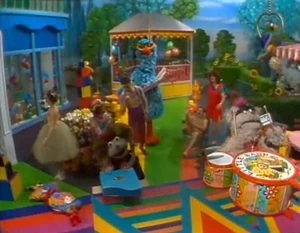
A shot from the show's eighth season opening sequence in 1984.
Every season features a different leader film for the Sesamstraat Tune. The first theme song for Sesamstraat was a translated version of the original Sesame Street Theme. For later seasons, a slightly altered version was recorded, with lyrics by Hans Dorrestijn. Despite viewers' complaints about the lyrics "Laat je speelgoed staan voor Sesamstraat" (put your toys aside for Sesamstraat) indicating that watching TV was more important than playing, these lyrics have not been changed since 1982.
A press release[1] states another complaint concerning the theme song in the early 1980's. Children tried to sing along with Frank Groothof (who sang the theme at the time), but couldn't reach the high pitch; this led to a key change from F major to C major.
During the early 1980's, instrumental versions of the theme song were used as background music or introductions for street scenes: one of which, with percussions by drummer Sly Dunbar, was released on the CD Sly Wicked and Slick.
Cast
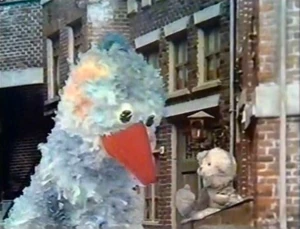
Early versions of Pino and Tommie in 1979
Puppeteers:
- Renée Menschaar as Pino (1991 - present, previously Tommie's right hand)
- Bert Plagman as Tommie (1979 - present, previously Pino in 1978)
- Catherine van Woerden as Ieniemienie (1980 - present)
- Judith Broersen as Purk (2003 - present, previously Tommie's right hand)
- Jogchem Jalink as Angsthaas (2008 - present)
- Eric-Jan Lens as Stuntkip (2008 - present)
- Lindai Boogerman (Ieniemienie's arm rods)
- Marijke Koek (Ieniemienie's arm rods)
- Daphne Zandberg (Tommie's right hand)
Previous puppeteers:
- Marijke Boon as Troel (1977)
- Leo Dijkgraaf as Pino (1984 - 1991)
- Dirk Grijspeirt as Pino (1976)
- Theo Joling as Pino (1977)
- Stef van der Linden as Tommie (1976 - 1977)
- Erik J. Meijer as Pino (1980 - 1984)
- Martin Pragt as Tommie (1978)
Actors
- Sien Diels as Sien (1976 - present)
- Piet Hendriks as Piet (1976 - 1984)
- Annet van Heusden as Annet (1976)
- Mieke Verstraete as Magda (1977 - 1981)
- Rudy Kühn as Rudi (1980 - 1985)
- Joyce Clements as Joyce (1980)
- Gerard Kuster as Gerard (1981 - 1987)
- Frank Groothof as Frank (1982 - present)
- Paula Sleijp as Paula and the Baroness (1982 - 2010)
- Aart Staartjes as Meneer Aart (1983 - present)
- Lex Goudsmit as Lex (1984 - †1999)
- Hakim Traïda as Hakim (1984 - present)
- Esther Prins as Esther (1984 - 1987)
- Gerda Havertong as Gerda and Peetje (1985 - present)
- Joekie Broedelet as Frank's Grandma (1987-1989)
- Lot Lohr as Lot (1988 - present)
- Rik Hoogendoorn as Rik (1993 - 2007)
- Elvan Akyildiz as Elvan (1996 - present)
- Martin van Waardenberg as Buurman Baasje (2003 - present)
- Mamoun Elyounoussi as Mamoun (2006 - present)
- Arjan Smit as Arjan (2008 - present)
Voices
- Paul Haenen as Bert, Grover, Fred the Wonder Horse, Buster the Horse, Dr. Nobel Price, Don Music, the Three Little Pigs, Japanese Storyteller, Captain Vegetable, Don Carrot, and Cyrus the Magpie
- Wim T. Schippers as Ernie, Kermit, Count von Count, Guy Smiley, the Amazing Mumford, Simon Soundman, Biff, Showered Rosell, Evil Prime Minister, Granny Fanny Nesslerode's Announcer, Toothbrush, Cavity, and Mr. Johnson
- Hein Boele as Elmo, Benny Rabbit, and Sherlock Hemlock (after 1980s)
- Peter Piekos (1970s-1980s) as Cookie Monster, Herry Monster, The Big Bad Wolf, Two-Headed Monster, Herbert Birdsfoot, Sherlock Hemlock, and Tough Eddie
- Hero Muller (1980s onward) as Cookie Monster, Herry Monster, and Two-Headed Monster
- Doris Baaten as Meryl Sheep, The Countess, Deena, and Polly Darton
- Tom Meijer as Placido Flamingo, Monty, and Joey Monkey
- Bill Van Dijk as Roosevelt Franklin, Little Chrissy, Bip Bippadotta, the lead singer of The Beetles, the shark ("Pearl White Teeth"), Travis Travel, and Clementine
- Hans Boskamp (until ± 2010) and Hans Hoekman (from ± 2010) as Oscar the Grouch
- Dick Poons as Hoots the Owl
- Sjef Poort as Forgetful Jones, Hard Head Henry Harris, Harvey Kneeslapper, and Oscar the Grouch ("Swamp Mushy Muddy")
- Lucie de Lange as Zoe, Roxie Marie, Cookie Monster's Mommy, and Count von Count's Mother
- Kas van Iersel as Davey Monkey and "Elmo's World" Announcer
- Reinder van de Naalt as Stinky the Stinkweed and Colambo
- Marjolein Algera as Natasha, Rosita, Suzie Kabloozie, and Athena
- Hellen Huisman as Prairie Dawn, Granny Fanny Nesselrode, Grover's Mommy, Cinderella, various Anything Muppet little girls, and Grundgetta
- Marlies Somers as Prairie Dawn
- Olaf Wijnants as Big Bird
- Cees van Oyen as Snuffy and Humphrey
- Marijke Merckens as Thelma Thumb
- Laura Vlasblom as Ruby
- Edward Reekers as Kingston Livingston III
- Alfred Lagarde (1980s-1997) and Fred Meijer (1998 onward) as Telly Monster
- Lesley van der Lek as Little Chrissy
- Maria Lindes as Baby Bear, Baby Natasha, Athena, Flo Bear and Cinderella's Fairy Godmother
- Peggy Vrijens as Abby Cadabby
Crew
- Producer: Jessica Fesenthal (2009-now), Astrid Prickaerts (-2009)
- Directors: Eric Blom, Sascha van der Feer (assistant director), Rita Goossens, Leo van der Goot, Norbert ter Hall, Ton Hasebos, Remy van Heugten, Rita Horst, Ineke Houtman, Jan Keja, Jan Keymeulen, Pieter Kramer, Joram Lürsen, Mike Naber, Aart Staartjes (location director), Refkele Steemers (assistant director)
- Writers: Marja Baeten, Sylvia de Boer, Heleen Bosma, Richard van Breukelen, Flip Broekman, Marianne Busser, Rob Chrispijn, Tingue Dongelmans, Hans Dorrestijn, Thea Dubelaar, Manfred van Eijk, Karel Eykman, Mylou Frencken, Hans Hagen, Monique Hagen, Marianne Harmsen, Conny van der Heijden, Eric Hercules, Mieke van Hooft, Marjet Huiberts, Luc Janssen, Trude de Jong, Willem Knigge, Mies Koppen, Ben Kuipers, Ted van Lieshout, Wim Meuldijk (1982-2002), Ries Moonen, Judith Nieken, Dirk Nielandt, Marianne van Nieuwpoort, Arthur van Norden, Theo Olthuis, Erik van Os, Casper Oudshoorn, Bas van Peijpe, Cindy Pieterse (2010-), Fetze Pijlman, Jan Riem, Bennie Roeters, Bas Rompa, Eus Roovers, Herman Roozen, Julius Ros, Ron Schröder, Patty Stenger, Otto Treurniet, Marc Veerkamp, Rian Visser, Willem Wilmink, Chris Winsemius, Driek van Wissen
- Music: Harry Bannink (original music), Harrie Geelen (song translator), Fay Lovski, Henny Vrienten (original music)
- Cinematography: Fred Brinkman (location), Paul Staartjes (location)
- Editing: Ajé Boschhuizen, Mylou Frencken (-2002), Jeroen Pelgrom, Henny Zwanenburg
- Costume Design: Mariëlle Sas
- Makeup Department: Gerda Beumer (makeup artist)
- Art Department: Erly Brugmans (production designer, 2005)
- Sound Department: David Carmiggelt (location), Bert Koops (sound recordist), Thanissis Plialis (location)
- Advisors: Hans Beentjes, Frea Janssen-Vos, Jan Kok, Peter Levelt, Aart Staartjes
- Translator: Ton Hasebos, John Tak
See also
- Sesamstraat Locations
- Sesamstraat Characters
- Sesamstraat Performers
- Sesamstraat Actors
- Sesamstraat Merchandise
- Sesamstraat Sketches
- Sesamstraat Specials
- Sesamstraat en Melkweg
Sources
- ↑ "Sesamstraat op de schop." January 9, 2014. Nos.nl

